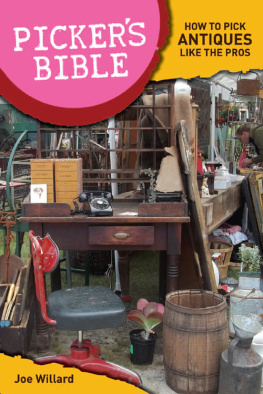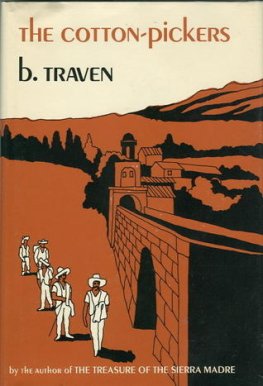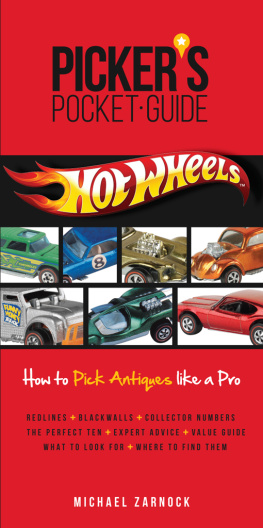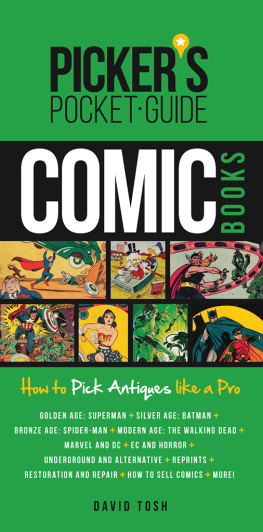Photos Copyright 2011 F+W Media, Inc.
Krause Publications, a division of F+W Media, Inc.
700 East State Street Iola, WI 54990-0001
715-445-2214 888-457-2873
www.krausebooks.com
Introduction
America Has Embraced Its Inner Picker
At one time, the notion of a dealer letting anyone (let alone admitting) know they hired a picker to find antiques and collectibles was a violation of an unwritten rule of the trade. The fact is dealers exhibiting at the finest antiques shows, selling haute decor to Hollywood elite, or supplementing museum holdings have all used a picker in some form or another. They are a necessary part of the great American treasure hunt that is the contemporary antiques business. If its true that the American antiques business is the last bastion of unregulated commercethe Wild West of capitalismthen pickers are its hired guns. Time and talent is for sale to the highest bidder. While the fine antiques dealer does more to elevate the aesthetics of an item, the picker embodies the hunt, wresting an item from the clutches of obscurity and decay.
Now, thanks to the explosion of reality TV shows, they have entered into a new era of American pop culture.
The show American Pickers on the History Channel and its growing number of imitators does a wonderful job putting the role of picker in a positive light. Sure its filled with gritty negotiations, haggling, speculation, and strategy that can, at some times, be uncomfortable to watch, but thats what makes the job fun. The public gets a ground floor perspective on what it truly takes to create wealth: buy low and sell high (or at least a little higher).
What the program does best, however, is show the time and tenacity it takes to be a good picker. After driving miles of back roads, clamoring over piles of forgotten metal and decades of cobwebs, the picker finds something they think can be resold to a network of buyers, cultivated over the years like a fine pearl. After all the work to locate the treasure, the picker haggles for a price, transports, and cleans the find and flips it quickly in a profitable sale. If you only focus on the work involved, the life of an antiques picker sounds downright daunting.
Look a little closer.

The picker is a 21st centurys mishmash of pirate, treasure hunter, Indiana Jones, and explorer. Few other lines of work reward a persons instinct, passion, and knowledge of minutiae in such a satisfying and profitable way.
What makes the pickers job so especially appealing at this time of economic uncertainty and limited job security is that it is within everyones reach; we all have a picker somewhere inside of us. The bargain hunting, the allure of the open road, living only on your wits and your design eye is a life most of us have fantasized about at one point or another.
So learn what you can and then apply it at your next garage sale or flea market. Who knows, maybe your next career will involve rust and cobwebs.
Many thanks to the army of freelance photographers who supplied images of various antiques shows, flea markets, and professional pickers used throughout this book: Danielle Bryant, Tom Hoepf, Wayne Jordan, Jack Kelly, Tom OHara, Rich Spidle, Deb Tobin, Sharon Thatcher, and Ken Yenke.
Kind thanks to antiques dealer Ed Welch, owner of Eyeglasses Warehouse of Waterville, Maine, whose portrait taken during the May 2011 Brimfield, Massachusetts, antiques show graces the back cover of this book. Mr. Welchs online shop may be found at eyeglasseswarehouse.com.
Eric Bradley, Editor of Antique Trader, www.antiquetrader.com
Chapter 1
Defining the Art:
Pickers and Picking

Jack Dixey of Canfield, Ohio, is a political memorabilia collector and dealer and a board member for the Ohio Political Items Collector Club. Here he poses witih an early 1930s Mickey and Minnie Mouse priced at $750 and $650, respectively.
You mean that collectors, antique dealers, and bookstores buy from a group or subculture of people called pickers?
The first time I ever heard about the term pickers was from a collector I know who had an entire basement filled with antique brass mining lamps. He also had walls loaded with miners candlestick holders and other mining memorabilia. I asked him how he could possibly find so many fantastic pieces from around here. He laughed then continued to tell me of how he had pickers from all over the country send him pieces to buy. He said they went to places such as yard sales, antiques stores, and thrift shops looking for items to send him. He told me it was almost as if he had hired them to look for him. I had never heard of such a thing. I was intrigued and had to know more. He said that these pickers knew about this particular collectible and knew he would pay good prices for the better pieces. He told me there were pickers for almost any type of collectible. His pickers had a good captive customer (him) and he had an endless supply of good items.
The next time I heard the term picker I was waiting in line in a library book sale. The old timer in front of me was explaining how he had to get there early in order to get in front of all the book pickers. Here was that term again. He described how some of the big book dealers had hired pickers to find certain titles for them.
This amazes me. You mean that collectors, antique dealers, and bookstores buy from a group or subculture of people called pickers? Exactly. Just about anyone who wants to can go picking and then bring the items to these dealers and sell them at the back door. The fact is, the majority of the inventory that many dealers have originated from the front lines of picking. What you see in an antique store or a museum is an assemblage of items. It didnt just happen. It was built over many years of gathering, finding, trading, and collecting. It was all harvested.
Think of the word picking or to pick. Have you ever said, Look what I just picked up or Boy, it was slim pickins today? Weve heard of berry pickers, stock pickers, fruit pickers, rag pickers, even a miners pick. These are all terms for harvesting, arent they? Antiques and collectibles pickers are, in fact, harvesters.












